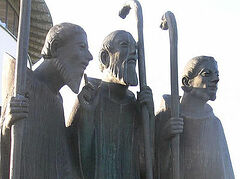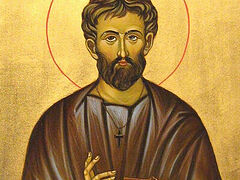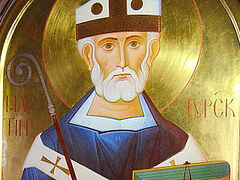Part 2: Missionaries and Enlighteners
Part 3: Great Monastic Saints and Penitents
Part 4: Holy Women—Martyrs, Abbesses, Nuns and Queens
We continue with an amazing series on the Orthodox saints of what is now call Benelux, by Matthew Hartley.
St. Lambert of Maastricht (†c.705)
St. Hubert of Liège (†727)
St. Wiro of Roermond (†753)
St. Frederick of Utrecht (†c.838)
St. Radbod of Utrecht (†917)
St. Ansfried of Utrecht (†1010)
Naturally, a number of holy hierarchs also adorned the Low Countries during the period of their Orthodox history. Great teachers, preachers, ascetics, and wonderworkers, they rank among the great saintly hierarchs of the world. A few will be discussed here.
St. Lambert, bishop of Maastricht, was a martyr for the sanctity and purity of Christian marriage. Like many of the saints featured here, he was of noble stock and was closely connected with other saints: St. Remaclus (see above) baptized him and served as his godfather. He was involved in Merovingian court life. Made bishop of Maastricht, he was sent into exile for a time to Stavelot Abbey. He assisted St. Willibrord’s missionary work. With St. Landrada (discussed above), he helped found the Abbey of Munsterblizen. He also mentored a young St. Hubert.
St. Lambert ran afoul of the political authorities for his refusal to compromise on Christian morals. Denouncing the adulterous behavior of Pepin, Mayor of the Palace, St. Lambert with his nephews Sts. Peter and Audolet was martyred at Liège, killed by troops for his refusal to tolerate infidelity. (He was pierced through the heart with a javelin). He is thus considered a martyr for marital purity.
 St. Hubert of Liège One of the more interesting backstories for a sainted bishop belongs to St. Hubert of Liège. St. Hubert was of Merovingian nobility, living in what is now the general region of Belgium and northeastern France. Like so many of his privileged station in life, he seems to have spent much of his time in frivolous pursuits. He was an especially avid hunter, into which hobby he threw himself with abandon after the untimely death (in childbirth) of his wife. His hunting addiction was such that he even disdained attending church on Good Friday, of all days, in order, yet again, to indulge his passion for the hunt. Yet this particular outing was to radically change his life.
St. Hubert of Liège One of the more interesting backstories for a sainted bishop belongs to St. Hubert of Liège. St. Hubert was of Merovingian nobility, living in what is now the general region of Belgium and northeastern France. Like so many of his privileged station in life, he seems to have spent much of his time in frivolous pursuits. He was an especially avid hunter, into which hobby he threw himself with abandon after the untimely death (in childbirth) of his wife. His hunting addiction was such that he even disdained attending church on Good Friday, of all days, in order, yet again, to indulge his passion for the hunt. Yet this particular outing was to radically change his life.
While pursuing a stag in the woods that day, a wondrous vision greeted St. Hubert: As the stag turned to face him, he suddenly beheld a magnificent shining cross framed between its antlers. (A similar vision, which came under similar circumstances, had been experienced by St. Eustathius (†118) centuries before). A voice then called out to him: “Hubert, unless you turn to the Lord, and lead a holy life, you shall quickly go down to hell.”
Understandably sobered by this vision and warning, St. Hubert rapidly amended his life. He renounced his noble titles and distributed his great wealth to the poor. As the voice had instructed, he sought out the spiritual tutelage of the pious local bishop, St. Lambert of Maastricht (see above). Under this guidance St. Hubert ascended rapidly in holiness and, following St. Lambert’s martyrdom, the pope named St. Hubert his successor.
St. Hubert became a great apostle to the region of the Ardennes, which still had much paganism remaining in it. He also served as the first bishop of Liège. He won many souls to Christ, and the idolatrous temples were destroyed. Moreover, he was an eloquent preacher. Having passed his later life in God-pleasing service, he reposed in peace in 727 and entered the heavenly kingdom.
St. Wiro (Wera) of Roermond, the holy hierarch, could also be classified among the great missionaries of this region. Of Anglo Saxon origin, he was a close companion of St. Willibrord and succeeded him as second bishop of Utrecht. He was also closely associated with St. Boniface. He engaged in missionary work along the Meuse River and was instrumental in collaboration with St. Plechelm (see above) in establishing the important and influential monastery at Sint Odiliënberg. His relics, which were lost for a time during the Reformation, were later rediscovered and are kept in Sint Odiliënberg, where they remain an object of pilgrimage. His holy skull is preserved in Utrecht.
 Icon of St. Frederick of Utrecht Another saint with an association with Utrecht is the holy hieromartyr St. Frederick. He was bishop of Utrecht from about 815-838. A man of great learning, the Vita, or Life, of St. Boniface is attributed to him. He, too, was an active missionary, having labored in Walcheren in Zeeland with St. Odulfus (see above). Elevated to the bishopric of Utrecht, he was later stabbed to death after celebrating Mass by men acting at the behest of the empress, likely in retribution for his frequent denunciations of her iniquitous conduct. Other accounts attribute the act to the instigation of pagans from Walcheren, who violently opposed St. Frederick’s missionary work. Upon his martyrdom he was immediately acclaimed a saint.
Icon of St. Frederick of Utrecht Another saint with an association with Utrecht is the holy hieromartyr St. Frederick. He was bishop of Utrecht from about 815-838. A man of great learning, the Vita, or Life, of St. Boniface is attributed to him. He, too, was an active missionary, having labored in Walcheren in Zeeland with St. Odulfus (see above). Elevated to the bishopric of Utrecht, he was later stabbed to death after celebrating Mass by men acting at the behest of the empress, likely in retribution for his frequent denunciations of her iniquitous conduct. Other accounts attribute the act to the instigation of pagans from Walcheren, who violently opposed St. Frederick’s missionary work. Upon his martyrdom he was immediately acclaimed a saint.
St. Radbod (Radboud) of Utrecht was one of a number of occupants of the Utrecht episcopal throne who, like Sts. Willibrord, Wiro, and Frederick, achieved sainthood. Others who should be mentioned include St. Eoban (†754), martyred at Dokkum with St. Boniface; St. Alberic, a missionary among the Teutons who helped St. Ludger (above); and St. Hungerus (†866).
St. Radbod was of noble birth and was quite well educated. Made bishop of Utrecht, he was forced to reside in Deventer due to the sacking of his episcopal see by the Normans. In addition to his episcopal duties, he was a writer of hagiographies, producing accounts of the lives of St. Boniface, St. Swithbert (†713, a companion of St. Willibrord), St. Amalia, and St. Servatius, among others. St. Radbod reposed in 917 while on a missionary journey.
The final holy hierarch to be covered here is St. Ansfried, who was likewise bishop of Utrecht. A late figure (he reposed in the early 11th century), his backstory is, like St. Hubert’s, one of the more remarkable to be found. He was the sword-bearer to Emperor Otto I, yet he voluntarily laid down his weapons to assume the bishopric of Utrecht.
He was born about the year 940, of noble stock. His uncle, under whom he studied as a youth, was archbishop of Trier. As a knight St. Ansfried was distinguished for his faithful service to the emperor and for the suppression of brigandage on his estates. With his pious wife, Hilsondis, he founded a church to St. Michael with a double monastery on one of his estates. His daughter, Benedicta, would serve as its first abbess.
After Hilsondis reposed in 994, St. Ansfried hoped to retire to a life of monasticism. However, the firm and persistent entreaties of Emperor Otto III at length prevailed upon him to accept the then-vacant bishopric of Utrecht. He laid his sword on the altar of the Blessed Virgin Mary, never to take it up again.
One of the most remarkable incidents from his time as bishop concerns his response to an impending Norman Viking invasion. (In those days Norman raids were a severe and constant threat across much of Northern Europe). When the Normans launched an invasion of Utrecht in 1006, Bishop Ansfried had the townsfolk set fire to their own homes. Seeing the smoke and rubble, the Normans left for other targets. Though seemingly an extreme measure, it is likely that it saved numerous lives.
St. Ansfried founded an abbey in Heiligenberg (near Leiden), to which he often withdrew. He donated all his extensive land holdings to the poor. Weakened from his ascetic struggles, he became blind in the last years of his life. He was known especially for his care for the poor and sick, feeding dozens of needy people daily, and would even tend to lepers and other sufferers personally. Upon his repose he was immediately revered as a saint—so much so that fighting nearly broke out between two towns over which should have the honor of having his relics (his daughter Benedicta managed to appease the quarreling sides). He was interred in Utrecht, in the Cathedral of St. Martin.
These holy hierarchs, with which the lands of the Low Countries were once gloriously adorned, shine across the centuries as great beacons of holiness. May we all draw inspiration from them, and have the great benefit of their prayers!
To be continued…




